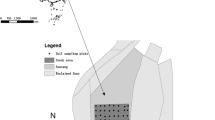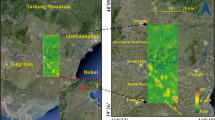Abstract
The spatial distributions and variation mechanism of key soil indices in the Qinling-Daba Mountains are important indicators for the identification of the transitional effect and regional characteristics of the north—south transitional zone in China. This manuscript analyzes the spatial variations in soil organic carbon (SOC) and total nitrogen (TN) and corresponding relationships with major geographical factors based on spatial analysis and geostatistics considering data obtained from the Second National Soil Survey. The results indicate that the spatial distributions of the SOC and TN contents are consistent, and three high-content areas, one secondary high-content area and one low-content area are observed. High content values are located in the high-altitude regions of the Qinling-Daba Mountains and mountainous areas to the west of the Jialing River, the low-content area occurs on the north slope of the Qinling Mountains, and the secondary high-content area mainly encompasses both sides of the Hanjiang River and regions in the Qinling-Daba Mountains at altitudes below 1000 m. The SOC and TN contents vary between the above two ranges, with the gradual increase in content revealing a horn-shaped pattern. Considering the spatial variations and functions of vegetation, topography and climate factors, it is found that the SOC/TN range in the secondary high-content area remains consistent along the 1000 m contour line, the upper limit of the transitional mountain altitudinal belt, the 0°C isotherm line in January and the 24°C isotherm line in July. This region constitutes the main body of the transitional zone between the subtropical and warm temperate zones, and the northern boundary is roughly distributed along the Dujiangyan-Maoxian-Pingwu-Wenxian line to the west of the Jialing River and the 1000 m contour line on the southern slope of the Qinling Mountains, while the southern boundary occurs along the Dujiangyan-Beichuan-Qingchuan line to the west of the Jialing River and the 1000 m contour line on the northern slope of the Daba Mountains. SOC/TN spatial variation provides a reference for the demarcation of the subtropical and warm temperate zones, and further identification of the soil processes and ecological effects in typical regions can help reveal multidimensional transitional characteristics and variation mechanisms.
Similar content being viewed by others
References
Catoni M, D’Amico M E, Zanini E et al., 2016. Effect of pedogenic processes and formation factors on organic matter stabilization in alpine forest soils. Geoderma, 263: 151–160.
Davidson E A, Janssens I A, 2006. Temperature sensitivity of soil carbon decomposition and feedbacks to climate change. Nature, 440(7081): 165–173.
Fang J Y, 1991. Eco-climatic analysis of forest zones in China. Acta Ecologica Sinica, 11(4): 377–387. (in Chinese)
Fang J Y, 2001. Re-discussion about the forest vegetation zonation in eastern China. Acta Botanica Sinica, 43(5): 522–533. (in Chinese)
Fang Z, Gao S Z, 1963. Vegetation vertical belt on the north and south slopes of Taibai mountain in Qinling Mountains. Journal of Plant Ecology and Geobatany, 1(Suppl.1): 162–163. (in Chinese)
Guo B, Zhang J, Meng X et al., 2020. Long-term spatio-temporal precipitation variations in China with precipitation surface interpolated by ANUSPLIN. Scientific Reports, 10(1): 81.
Gao G M, 1986. The natural vertical zone of Shennongjia Mountain. Journal of Mountain Research, 4(4): 282–286. (in Chinese)
Huang K, 1979. Vegetation vertical zone on the north slope of Daba Mountain. Journal of Shaanxi Normal University (Natural Science Edition), 7(1): 151–154.
Institute of Forestry, Chinese Academy of Forestry (IFCAF), 1986. Chinese Forest Soil. Beijing: Science Press. (in Chinese)
Kang M Y, Zhu Y, 2007. Discussion and analysis on the geo-ecological boundary in Qinling Range. Acta Ecologica Sinica, 27(7): 2774–2784. (in Chinese)
Kögel-Knabner I, Amelung W, 2021. Soil organic matter in major pedogenic soil groups. Geoderma, 384: 114785.
Lei M, Chang Q R, Feng L X et al., 2001. Soil characteristic and genetic feature of iron oxide of Taibai Mountains. Geographical Research, 20(1): 83–90. (in Chinese)
Li D C, Zhang G L, 2016. On difficulties and countermeasures in describing soil series in Chinese soil taxonomy. Acta Pedologica Sinica, 53(6): 1563–1567. (in Chinese)
Li S S, Lu J Y, Yan J P et al., 2018. Spatiotemporal variability of temperature in northern and southern Qinling Mountains and its influence on climatic boundary. Acta Geographica Sinica, 73(1): 13–24. (in Chinese)
Liu Y H, 1980. On natural zonation in the Shaanxi Province. Acta Geographica Sinica, 35(3): 210–218. (in Chinese)
Liu Y S, 2001. Structural analysis and optimal use of land types in mountainous regions: Taking Qinling Mountains of Shaanxi Province as an example. Acta Geographica Sinica, 56(4): 426–436. (in Chinese)
Long J, Liu Y, Xing S et al., 2020. Optimal interpolation methods for farmland soil organic matter in various landforms of a complex topography. Ecological Indicators, 110: 105926.
Ma J H, 2004. Laws of soil vertical variations on southern slope of Funiu Mt.: Simultaneous study on north boundary of subtropical zone. Acta Geographica Sinica, 59(6): 998–1011. (in Chinese)
Ma J H, Han J X, Zhao Q L, 2002. The division between subtropical zone and warm temperate zone according to the compositions and properties of soil humus. Journal of Mountain Research, 20(3): 272–276. (in Chinese)
Ma M Z, Shen G Z, Xiong G M et al., 2017. Characteristic and representativeness of the vertical vegetation zonation along the altitudinal gradient in Shennongjia Natural Heritage. Chinese Journal of Plant Ecology, 41(11): 1127–1139. (in Chinese)
Ren M E, Yang R Z, 1961. China’s natural division. Acta Geographica Sinica, 27(12): 66–74. (in Chinese)
Shen Z H, Zhang Q F, Yue C et al., 2006. The spatial pattern of land use/land cover in the water supplying area of the middle-route of the South-to-North Water Diversion (MR-SNWD) Project. Acta Geographica Sinica, 61(6): 633–644. (in Chinese)
Ünver İ, Madenoğlu S, Dilsiz A et al., 2013. Influence of rainfall and temperature on DTPA extractable nickel content of serpentine soils in Turkey. Geoderma, 202/203: 203–211.
Wang J L, Liu Q R, Meng S Y et al., 2010. Division of the geo-ecological boundary in Qinling Mountain Range based on the composition and geographical elements of its Pteridophyta flora. Geographical Research, 29(9): 1629–1638. (in Chinese)
Xue Z L, Wang J M, 2010. Vegetation distribution pattern in Micang Nature Reserve located in the west part of Bashan Mountains. Shaanxi Forest Science and Technology, 38(6): 27–31, 41. (in Chinese)
Yao Y H, Kou Z X, Hu Y F et al., 2020. Spatial distribution patterns of Pinus tabulaeformis forest and Pinus massoniana forest in Qinling-Daba Mountains and the boundary of subtropical and warm temperate zones. Acta Geographica Sinica, 75(11): 2298–2306. (in Chinese)
Ye Y Z, Yang Q P, Weng M et al., 1999. Studies on forest community diversity in Funiu Mountain I: Vertical distribution of community and species richness. Henan Science, 17(Suppl. 1): 61–64. (in Chinese)
Ying J S, Li Y F, Guo L F et al. 1990. Observations on the flora and vegetation of Taibaishan, Qinling Mountain range, southern Shaanxi, China. Acta Phytotaxonomica Sinica, 28(4): 261–293. (in Chinese)
Ying J S, Ma C G, Zhang Z S, 1979. Observations of the flora and vegetation of Mt. Shennongjia in western Hubei, China. Acta Phytotaxonomica Sinica, 17(3): 41–60. (in Chinese)
Zhang B P, 2019. Ten major scientific issues concerning the study of China’s north-south transitional zone. Progress in Geography, 38(3): 305–311. (in Chinese)
Zhang D X, Shi X Z, Yu D S et al., 2002. The basis for establishing China’s 1:1000000 soil database. Acta Geographica Sinica, 57(Suppl.): 82–86. (in Chinese)
Zhang J H, Li G D, Wang Y S et al., 2020. Spatial characteristics and variation mechanism of different soil organic carbon components in the alluvial/sedimentary zone of the Yellow River. Acta Geographica Sinica, 75(3): 558–570. (in Chinese)
Zhang J Q, 1981. Division between subtropical zone and temperate zone in Henan Province according to geo-botany. Acta Geographica Sinica, 36(2): 216–222. (in Chinese)
Zhang X Z, Zhang Z Y, 1979. A preliminary discussion on the northern boundary of subtropical zone in China: Based on the distribution of broadleaf woody evergreens on the Qinling Mountain. Acta Geographica Sinica, 34(4): 342–352. (in Chinese)
Zhang Y J, Yu Y C, Niu J J et al., 2020. The elevational patterns of soil organic carbon storage on the northern slope of Taibai Mountain of Qinling. Acta Ecologica Sinica, 40(2): 629–639. (in Chinese)
Zhao F, Zhang B P, Zhu L Q et al., 2019. Spectra structures of altitudinal belts and their significance for determining the boundary between warm temperate and subtropical zones in the Qinling-Daba Mountains. Acta Geographica Sinica, 74(5): 889–901. (in Chinese)
Zhao T, Bai H Y, Deng C H et al., 2019. Topographic differentiation effect on vegetation cover in the Qinling Mountains from 2000 to 2016. Acta Ecologica Sinica, 39(12): 4499–4509. (in Chinese)
Zheng D, Yang Q Y, Wu S H et al., 2008. Study on Ecogeographic Regional System of China. Beijing: The Commercial Press. (in Chinese)
Zhou Q, Bian J J, Zheng J Y, 2011. Variation of air temperature and thermal resources in the northern and southern regions of the Qinling Mountains from 1951 to 2009. Acta Geographica Sinica, 66(9): 1211–1218. (in Chinese)
Zhu K Z, 1958. Subtropics of China. Chinese Science Bulletin, 9(17): 524–528. (in Chinese)
Zhu M, Feng Q, Qin Y Y et al., 2019. The role of topography in shaping the spatial patterns of soil organic carbon. CATENA, 176: 296–305.
Author information
Authors and Affiliations
Corresponding author
Additional information
Foundation: National Scientific and Technological Basic Resources Investigation Project, No.2017FY100900; National Natural Science Foundation of China, No.42171112; Key Research and Development Project in Henan Province, No.212102310415
Author: Zhang Junhua, Professor, specialized in soil environmental change and land surface processes.
This paper is initially published in Acta Geographica Sinica (Chinese edition), 2021, 76(9): 2269–2282.
Rights and permissions
About this article
Cite this article
Zhang, J., Zhu, L., Li, G. et al. Distribution patterns of SOC/TN content and their relationship with topography, vegetation and climatic factors in China’s north-south transitional zone. J. Geogr. Sci. 32, 645–662 (2022). https://doi.org/10.1007/s11442-022-1965-x
Received:
Accepted:
Published:
Issue Date:
DOI: https://doi.org/10.1007/s11442-022-1965-x




